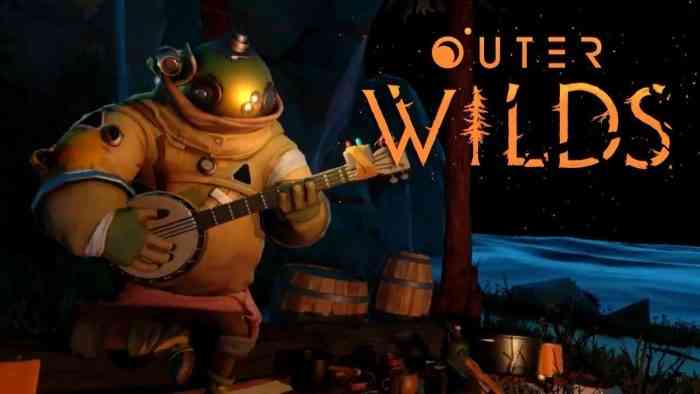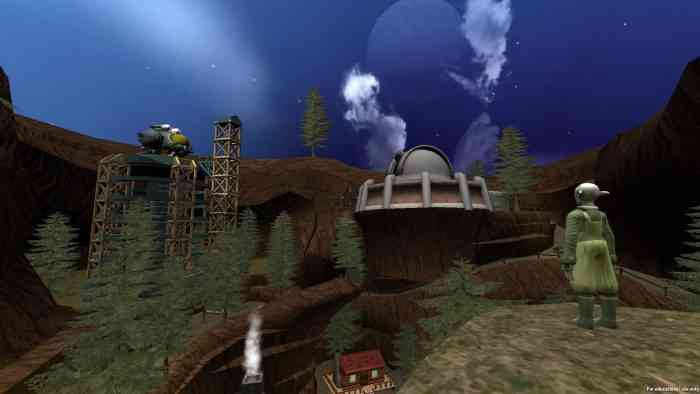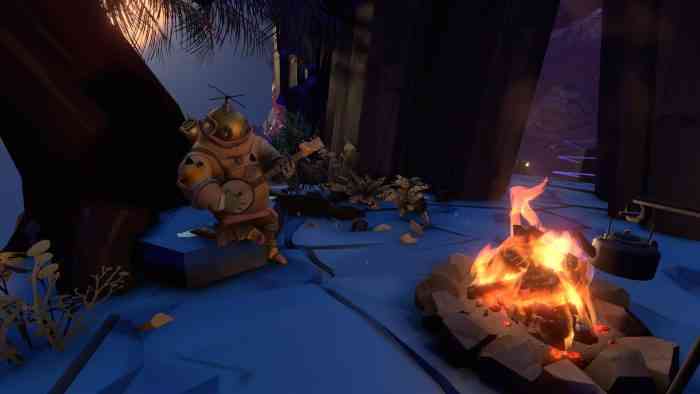Outer Wilds Review
Albert Einstein once referred to the phenomenon of quantum entanglement as “spooky action at a distance.” If there’s one thing I find captivating about our universe, it’s this spooky action being possible. Quantum entanglement is best described in an example you’ll find tossed around quite often: if one observes a particle in one place, another particle (no matter how far away) will instantly change its properties. Of course, the actual definition behind it requires familiarity with physics and math at a deeper level (a level beyond on my own brain’s means).
Nowadays, it’s one thing to ponder such a phenomenon in atoms and electrons, but it’s another thing to consider some experiments showing it can occur in objects almost visible to our naked eyes. These ideas often lead me down a rabbit hole of questions around the true nature of our universe, our reality, and our perception of time and space.
Outer Wilds (not to be confused with the upcoming Outer Worlds by former Fallout peeps) is a game built around the physics and mysteries of the universe – both familiar to us and those unknown. While laws we know like gravity still apply and work as they do in our solar system, other laws remain to be discovered by you the player. And it’s in the self-discovery of these concepts through Outer Wilds’ engrossing backstory and setting that puts it well above other titles of its genre.

Where games like No Man’s Sky dazzled us with its machine generated (and nearly infinite) worlds to explore, I always felt a bit dismayed. Traversing No Man’s Sky’s universe often felt like an exercise in repetition with only the window dressing ever feeling all that different. Occasionally I’d meet a different race of aliens, or land on a planet with hilariously phallic-looking fauna, but outside of a laugh and a screenshot, none of it really made me care all that much.
In the years following, the developers of No Man’s Sky brought to bear a lot more handcrafted content to mix into their procedural machine. Over time I started to wonder what could a talented group of developers accomplish if they took the best parts of No Man’s Sky interplanetary exploration and created handcrafted worlds for us to explore?
Well, my intrepid space explorer, you’ll be pleased to hear Outer Wilds is that perfect and sublime answer.
Tip of the Iceberg
I’ll start with this small but important warning: If you are at all interested in Outer Wilds, the less you know going in the better experience you will have. I’ll outline the core of what this game is and do my best to dance around large spoilers, but I do implore you to avoid reading too much about it. If you think this game might scratch that space exploration itch you’ve had for the past while, go get it. Skip down to my review score then go lock yourself in a quiet place, block out any intruders, and begin uncovering the giant iceberg of a universe before you.
I say iceberg because Outer Wilds is small in scope but incredibly large in depth. What feels like an incredibly tiny solar system of planets at first (the entire play area is less than 50km in diameter) will start to give way to more and more as you start to solve its more immediate mysteries.
At its most basic explanation, Outer Wilds is a walking simulator in space with a few tiny survival mechanics: namely oxygen to breathe and fuel for your spacesuit. There are no resources to harvest or things to build. There is no skill tree or upgrade path. There is no voice acting either, but the characters you meet are often funny enough in text or weird enough that you won’t mind. Lastly, there’s nothing to kill but there are things out there that can kill you quite easily.

You play the role of a Hearthian astronaut. The Hearthians are a many-eyed humanoid race that happens to be the predominant species in this solar system. They’ve got space travel mostly dialed in. If by dialed in I mean stapled together with some extra duct tape, then you’ll see where they’re coming from.
After a short introduction where you’re taught the basics of flying a spaceship, moving in zero gravity environments, and the dangers of the peculiar ‘ghost matter’, you’re free to then explore as you see fit. Your fellow Hearthians will leave you a couple of breadcrumbs to get you started on your journey in the stars but after that, you’re left entirely on your own.
Lost in Space
It’s striking how fast your ship becomes your home and how your spacesuit becomes your lifeline to safety. You come equipped with a signalscope that lets you track unknown sounds in the solar system, which is helpful when you’re starting out. You also have access to a probe that doubles as a handy lantern or hazard detector and, most importantly, you carry a Nomai translator – the first translator of its kind. This portable translator is what sets you apart from explorers before you. Until you, there was no way to understand the ancient alien writings you’ll find scattered across the stars.
The Nomai are an ancient alien race that mostly vanished and died out. Lucky for you, they were science-minded and the big questions surrounding them like where they went, what they were trying to do and what they left behind will take you across Outer Wild’s entire story while also furthering your understanding of this universe. In trying to answer these questions you will find even more questions. It will eventually culminate in a tapestry of rich history and lore that you’ll constantly admire as you piece everything together bit by bit.
If you’re ever lost in the details, your ship comes equipped with a handy map that can also work in ‘rumour mode’. Think of this mode as a detective view of your own notes. Everything discovered is recorded and organized for you. If something has an important relationship to another discovery you just made, an arrow will be drawn indicating as such that also describes its relationship. The rumour mode is indispensable at knowing what you have to do and what you haven’t finished exploring. It’s greatest feature to mark where you may have missed something with an icon, challenging you to come back is a godsend.
Small Spoilers Ahead
I’m going to get into light spoiler territory now so consider this your last warning. If you want to go in blind about how this universe works (which I highly recommend), stop reading now!
Okay, still here? Good. Now let’s talk about some funky weirdness.
Outer Wilds is not a scary game, though some situations can be tense and spooky. While you may not die right away, eventually you’ll live long enough to see the sun supernova. It may happen to you when you’re deep in a planet’s core (like me), or out when you’re flying around. You will likely have no idea what just happened.

However, sooner or later you’ll spot the sun in its bright zenith and gasp in surprise as the supernova expands to engulf everything around it, you included.
Upon death all your memories (like a creepy gameplay recording) will flash before your eyes while giant alien-looking statues stare at you in a spooky gaze. After this sequence you’ll awaken back where it all started on your home planet. Nobody but you will know that you died. Everything is just as before. Or is it? It’s Groundhog Day in space and you have no idea why you came back. This mechanic plays into the story. You can ask others about your death, but they’ll shrug like you’re slowly losing your marbles.
So now one of the first laws of Outer Wilds becomes known: you exist in a limited time loop.
You can explore as much as you are able but like clockwork the sun will explode and there isn’t much you can do about it. And if you die to something other than the sun exploding, you’ll reset the time loop anyway.
Each loop you’ll uncover secrets and knowledge, and luckily these will persist beyond death, allowing you to delve deeper and deeper while juggling your time limit. The death timer never feels short enough that it’s a total hindrance, but it also never feels quite long enough as you push ever onward, hoping you have enough time left to get to the next bit of knowledge.
It’s also a clever bit of game design, allowing for certain predefined sequences to play out over and over again until you’re ready to interfere with them.
Spooky Action at a Distance
There are other things at work in this universe and it won’t take you long to notice them.
Certain objects you find early on are very weird, constantly shifting places while not being directly observed. Mastering the lessons these objects teach you will give you access to even more secrets long forgotten and unlock areas you didn’t know were possible. There’s nothing quite like the feeling of understanding a new concept and using it to your advantage without any hand holding on how the mechanic works.
The planets themselves are unique in their behavior and construction. One planet will fill up with sand as you dive its depths while its nearby moon instead loses that same sand, allowing you to traverse formerly hidden caves. Another planet is made entirely of water and cyclones that push you back into orbit, challenging your skills as a pilot.
Gravity, light, sound, tornados, and even dead fish are up for scientific understanding and eventual manipulation. Nothing exists to not be used somehow.
These laws and physics of the solar system are often interconnected in surprising ways, leading to further mind-bending discoveries such as taking into account the positions of planets at a given time, or where a planet may be facing as it orbits the sun. It’s all so precise and expertly constructed that you’ll start test out your own hypotheses to accurate results.
Ruins and ancient structures left behind by the Nomai will further flesh out these secrets, as they too were on a journey of scientific understanding. The constant loop of exploration, learning, and applying what you learn never gets old in Outer Wilds and there’s something so unique about how it all comes together. You really start to feel like a scientist.
If I had any gripes to pick with such a masterful execution of an experience it’s that these laws are unwavering in their consistency. If you are not careful you will pay the price of dying earlier than you intended. I can’t tell you how many times I got lazy and flew too close to the sun only to be pulled in by its gravity and fried. Or the many times I fell into a black hole I was exploring only to warp across the stars with just a tiny jet pack and three minutes left of air.
Space can quickly become dangerous if you relax too much. And Given there’s no checkpointing system your loop will start over, forcing you to pick up from the beginning and retry whatever it is you were trying to do. This can be frustrating for longer sessions.
And there’s the whole business of Outer Wilds becoming an Epic Games Store exclusive to the surprise of some backers (and such things with Epic are never without controversy these days).
But all that said, Outer Wilds does what it sets out to do so well that I can give it no higher praise than say it’s a must-have game for any of us interested in outer space and science fiction. It takes the lessons from games before it, mixes in some actual spooky physics, and leans on its handcrafted nature to great impact. While small in scope there’s so much to uncover you will never want it to end.
There’s so much to talk about that most of it is truly best left unsaid, as your path to these discoveries will be very much your own. I hope bigger games take some of Outer Wilds’ design lessons to heart. There’s nothing quite like it right now and there should be.
***PC code was provided by the publisher***
The Good
- Incredible rich solar system to explore
- A captivating and mysterious story
- An accessible interface tracks everything
- The physics of the universe
The Bad
- A certain story mechanic flawed

